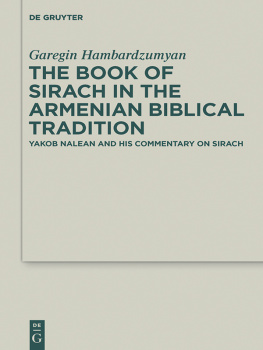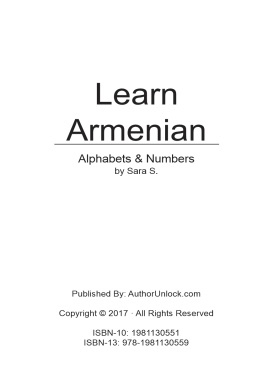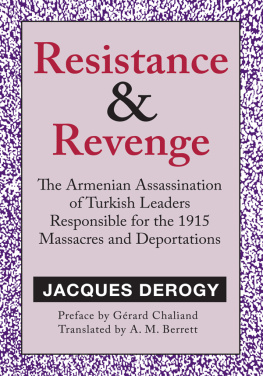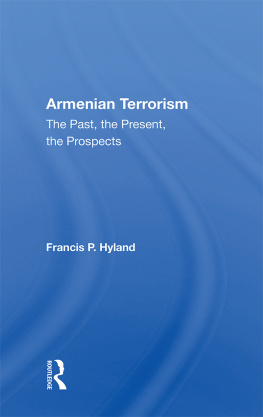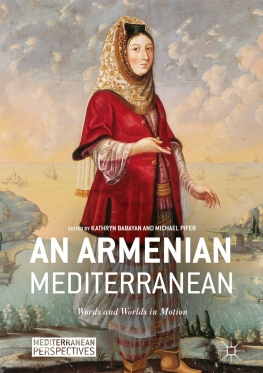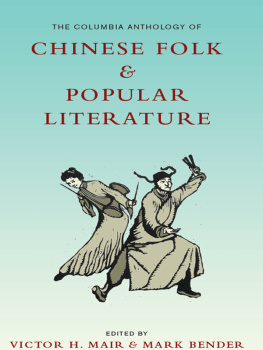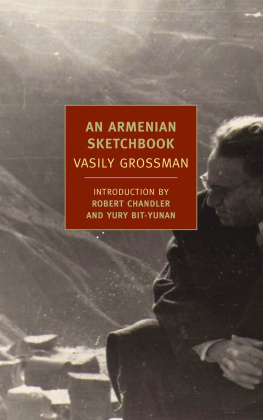Nairi Zarian - Davit of Sassoun: Armenian Folk Epic
Here you can read online Nairi Zarian - Davit of Sassoun: Armenian Folk Epic full text of the book (entire story) in english for free. Download pdf and epub, get meaning, cover and reviews about this ebook. year: 2016, publisher: David Hakobyan, genre: Detective and thriller. Description of the work, (preface) as well as reviews are available. Best literature library LitArk.com created for fans of good reading and offers a wide selection of genres:
Romance novel
Science fiction
Adventure
Detective
Science
History
Home and family
Prose
Art
Politics
Computer
Non-fiction
Religion
Business
Children
Humor
Choose a favorite category and find really read worthwhile books. Enjoy immersion in the world of imagination, feel the emotions of the characters or learn something new for yourself, make an fascinating discovery.
- Book:Davit of Sassoun: Armenian Folk Epic
- Author:
- Publisher:David Hakobyan
- Genre:
- Year:2016
- Rating:5 / 5
- Favourites:Add to favourites
- Your mark:
- 100
- 1
- 2
- 3
- 4
- 5
Davit of Sassoun: Armenian Folk Epic: summary, description and annotation
We offer to read an annotation, description, summary or preface (depends on what the author of the book "Davit of Sassoun: Armenian Folk Epic" wrote himself). If you haven't found the necessary information about the book — write in the comments, we will try to find it.
Davit of Sassoun: Armenian Folk Epic — read online for free the complete book (whole text) full work
Below is the text of the book, divided by pages. System saving the place of the last page read, allows you to conveniently read the book "Davit of Sassoun: Armenian Folk Epic" online for free, without having to search again every time where you left off. Put a bookmark, and you can go to the page where you finished reading at any time.
Font size:
Interval:
Bookmark:
NAIRI ZARIAN


ARMENIAN FOLK EPIC

ARTWORK BY
KHOREN HAKOBYAN
We are grateful to Anna Hakobyan, Babgen Rostomyan,
Armen and Richard Kocharyans and all other supporters, who greatly contributed to the publication of this book.

Grigor Khanjyan
Opening address
I have the pleasure of sharing a couple of words about Khoren Hakobyan, his painting, art and especially this series of canvasses, entitled Davit of Sassoun . I got to know Khoren Hakobyan closely when working with him for the magazines Pioner ( Pioneer ) and Tsitsernak ( Swallow ). Then I saw a painter who had a tender heart, was full of humor, and possessed a flexible drawing style. I really believe that he managed, through his expressive and meaningful works, to instill a sense of beauty in the hearts of the younger generation who read and enjoyed Tsitsernak and Pioner . As the years went by, Khoren Hakobyans art became more powerful, acquiring a solid nature, an experience of life and a philosophy. What I saw in his studio came as a discovery to me, because I did not know that side of Khoren Hakobyan's personality. And now, you too may see this character. A true artist must by all means have transitional phases in his life and never limit himself to saying, I am the connoisseur of this particular genre of art. Yes, a true artist must always be in quest of something. But that quest should not be formal in its essence. I mean the kind of quest which conveys a meaning and shapes a kind of art full of idea. We, the artists of the elder generation, are often criticized for not understanding modern art and not being able to give it a due appreciation. I dont think those people are right, as contemporary art too, has an idea, and a philosophy of its own. And if it is based on that and conveys a message, that art is really impossible to reject. But when an artists inability and failure to try and work painstakingly lays the foundations of a new form of art, it isnt acceptable. Thats something that was proven in art over the course of time. I am not the kind of person who becomes endlessly devoted to a kind of activity once he or she develops a liking for it. He can search and find. And thats what I feel Khoren Hakobyan really did. He dared to undertake Davit of Sassoun after a long creative experience. And it was really surprising to me that he was able to convert his small and tender graphic designs into illustrations that stand out with their articulated Armenian style; breathing epic spirit and monumental artistry, featuring heroes who will remain in our minds forever.
The point is that the more artists, there are the more styles and interpretations. That is where the secret of art hides; otherwise, one artist would be enough for all people. Once again, I witness Davit of Sassoun being illustrated, after a celebration marking the epics one thousandth anniversary. I believe that Khoren Hakobyans Davit of Sassoun has an interpretation and an approach of its own. He saw the heroes in a way which was in harmony with his spirit. I find that this is of paramount importance, because if one artist uses the features of another, whether they be more powerful or weaker, that is already a shortcoming. At all costs, an artist must strive to go beyond predetermined frameworks, and Khoren did; this artist's concepts and images are all his own.
That is a great success.
Grigor Khanjyan
Peoples Artist of Armenia
1994 (excerpt from opening address delivered at the exhibition Davit of Sassoun)
Illustrated by Khoren Hakopyan
Dickran Kouymjian
Scholars of epic literature have emphasized from the beginning of comparative studies devoted to them that the dynamic improvisation and poetic evolution of this, the most developed of oral literary forms, stops when the story or saga recited or sung by the bard or minstrel is written down. Surely this was a major factor in sealing the development of what is now called Davit of Sassoun and regarded today as the Armenian national epic. The publication of the first transcribed variant of Sasna tsrer (literally the crooked or bent ones of Sassoun, that is different than straight or normal, thus iconoclasts, non-conformists, independent beings), as the various versions of the saga were called when Fr. Garegin Srvandztiants recorded what he heard from an illiterate reciter in 1873 and published the first ever version of it in Constantinople the following year. The epic continued to be recited decades after in the countryside of Western Armenia around Sassoun and Moush, about fifty kilometers southwest of Van, and neighboring areas, as we know by the collection of other, often very different, versions in the following decades. The ultimate end of the living oral tradition was provoked by the Armenian Genocide committed by successive Turkish governments, which removed through murder and exile the entire native population of Western Armenia. Only those who had learned to recite one or another of the various versions and who survived the physical destruction of the Armenians were able to repeat the epic, in part or in whole, years later when aggressive campaigns in the Armenian Republic were initiated to uncover and transcribe verbatim all versions still remembered among western Armenians who had taken refuge in the new homeland.
The oral epic recited by the ashough or bard was not just a great feat of memory, but one of creative inspiration with the usually illiterate, often itinerant, poet adding details or modifying story lines as the situation called for or his memory skills required. It was during the first phase of this post-Genocide fieldwork of preserving the variants among those who still remembered them, that members of the corresponding branch of the Soviet Academy of Sciences in Armenian decided to edit a digestible and coherent epic out the greatly divergent versions already published or recorded; it was necessary to synthesize the 65 known variants into a single and singular work. In 1938 a team of philologists was assigned to this task Manouk Abeghyan, Gevorg Abov, and Aram Ghanalanyan all of whom had first hand experience transcribing variants among peasant-class, mostly illiterate storytellers; the overall editor was Academician Hovsep Orbeli. They had a deadline to finish this work of synthesis by September 1939, which the Soviet Armenian authorities decided to celebrate, somewhat arbitrarily, as the thousandth anniversary of the creation of the epic of Sassoun. In the process of accomplishing this task, the once regional story of the heroes of the Sassoun-Taron-Moush region was transformed into a national one and given the title Davit of Sassoun, The Armenian Folk Epic.
Davit of Sassoun is caught between the fate of epic poems that have stopped evolving because they are no longer recited by bards from memory, that is the oral tradition gave way to a written or literary epic, and the most unusual phenomenon that the raw material, now some 130 variants of the Sasna tsrer reflecting nuances and interpretations only partially incorporated into the official text are most published in their original dialectical form. Among the many striking features of the Sassoun epic compared to the great poems of this genrethe Homeric epics, the Scandanavian Sagas, Shahnameh, the Georgian epic, Niebelungen Lied, Song of Roland, Song of Prince Igortwo are quite remarkable. Within the very rich Armenian literary tradition spanning nearly 1500 years from the creation of the alphabet until the Davit variants were collected and published, a tradition very rich in historical and poetic writing, not once is the epic of Sassoun or any of its protagonists mentioned. Its various cycles were passed down orally for at least a millennium by illiterate bards; they were ignored or simply unknown to the educated class of clergymen and notables. Because of this total historical silence, when the first variants were gathered and published some thought the work was a creation of the recent pre-modern period. However, research has revealed its clear mention by a twelfth-century Arab writer as well as two sixteenth-century sources, the Kurdish epic the Sharaf Nameh and a Portuguese travel account. Its second unusual feature is the simultaneous creation and publication of the commissioned synthetic version and the scores of diverse variants used to create it. Homers consolidation of the numerous narratives at his disposal to compose the Iliad and the Odyssey is similar to what the troika of scholars did in 1939, but in the Greek poets case, we have none of the variants he worked with only a few fragmentary lines from earlier stories.
Font size:
Interval:
Bookmark:
Similar books «Davit of Sassoun: Armenian Folk Epic»
Look at similar books to Davit of Sassoun: Armenian Folk Epic. We have selected literature similar in name and meaning in the hope of providing readers with more options to find new, interesting, not yet read works.
Discussion, reviews of the book Davit of Sassoun: Armenian Folk Epic and just readers' own opinions. Leave your comments, write what you think about the work, its meaning or the main characters. Specify what exactly you liked and what you didn't like, and why you think so.


